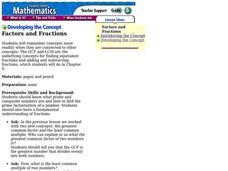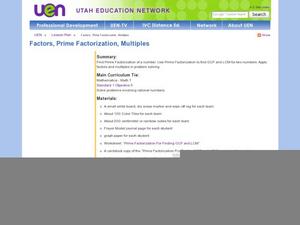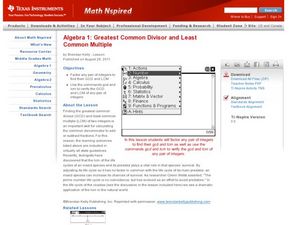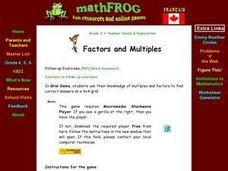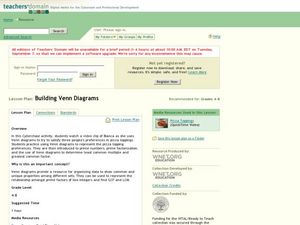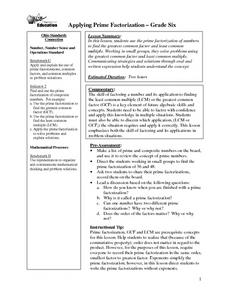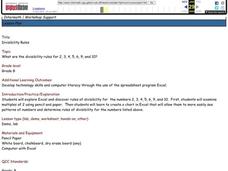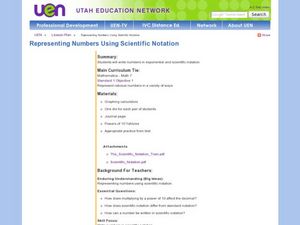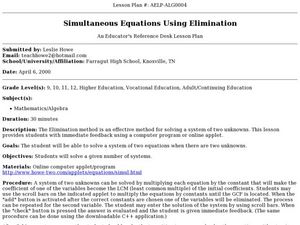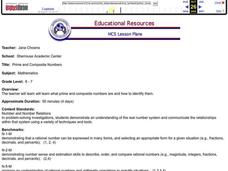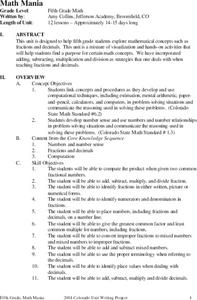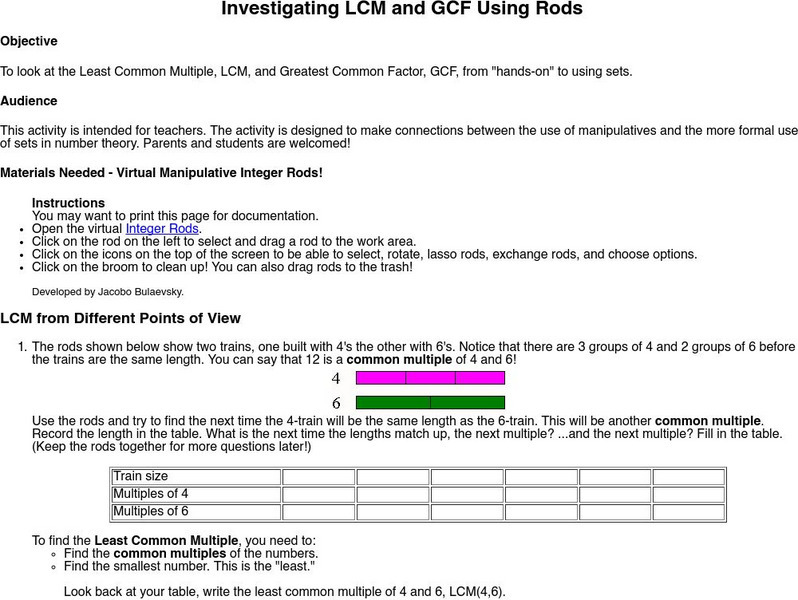EngageNY
Least Common Multiple and Greatest Common Factor
Find the common denominator between prime factors, factor trees, and the distributive property. Scholars learn to find the least common multiple and greatest common factor of pairs of numbers. They rotate through stations to connect...
Curated OER
Factors and Fractions
Find the greatest common factor of numbers. Learners review prime and composite numbers and how to find the prime factorization of a number. They also review the greatest common factor, least common multiple, and learn new ways to find...
Curated OER
Greatest Common Factor and Least Common Multiple Story Problems
In this story problems worksheet, students determine whether to find either the greatest common factor or the least common multiple in order to solve the problem.
Curated OER
Factor Fun for Fifth Graders
Fifth graders explore common factors. In this factorization lesson, 5th graders discover the greatest common factor among two numbers in a game format. Students build on previous knowledge to determine the greatest common factor.
Curated OER
Factors, Prime Factorization, Multiples
Seventh graders examine Prime Factorizations, Multiples, and Factors. In this prime number, factorization, and multiples lesson, 7th graders identify greatest common factors and least common multiples. Students use problem solving skills...
Texas Instruments
Greatest Common Divisor and Least Common Multiple
Students solve problems using the GCD and LCM. In this algebra lesson, students factor and simplify equations using the greatest common and least common factors and multiples. They factor integers in pairs.
Curated OER
Lesson 56
Sixth graders practice Least Common Multiple in fractions. In this fraction lesson, 6th graders look at two different fractions and find a common denominator. They sing a song to memorize mean, median, and mode.
Curated OER
Factors and Multiples
Sixth graders need to see the relevance in the mathematics they learn. This lesson plan builds on the concepts of least common multiple and greatest common factor. The lesson plan presents real-world problem situations for students to...
Curated OER
Building Venn Diagrams
Students use Venn diagrams to solve prime number and factorization problems. In this multiplication lesson, students watch a video and use a Venn Diagram to help them solve a pizza math activity that uses prime factorization. Students...
Curated OER
Applying Prime Factorization
Sixth graders use the prime factorization of numbers to find the greatest common factor and least common multiple. Working in small groups, they solve problems using the greatest common factor and least common multiple.
Curated OER
Pascal's Triangle
Students explore the concept of Pascal's Triangle. In this Pascal's Triangle lesson, students use an applet called 'Coloring Multiples' to explore Pascal's Triangle. Students develop patterns starting with various numbers in Pascal's...
Curated OER
Divisibility Rules
Eighth graders explore Excel and discover rules of divisibility for the numbers 2, 3, 4, 5, 6, 9, and 10; students examine multiples of 2 using pencil/ paper, then create a chart in Excel that will allow them to more easily see patterns...
Curated OER
Fraction Jeopardy
Students investigate basic concept of fractions by using a version of the game Jeopardy. The game is played using a television monitor or projector for the integration of technology. The lesson is highly engaging and can hold student...
Curated OER
Exponential Expressions - Perfect Squares, Square Roots
Color tiles are used to model perfect squares. Alone or in pairs, middle schoolers will find patterns. Afterward, the relationship between perfect squares and roots will be discussed as a whole class.
Curated OER
Representing Numbers Using Scientific Notation
Learners explore the concept of scientific notation. In this scientific notation lesson, mathematicians discuss how multiplying by a power of 10 affects the decimal. They play Powers of 10 Yahtzee. Students roll a die five times and each...
Curated OER
Simultaneous Equations Using Elimination
Students solve a system of two unknowns. In the Algebra lesson, students use a on line computer applet/program to solve a system by the elimination method. The student's work is self checking, giving immediate feedback. ...
Curated OER
Prime and Composite Numbers
Prime and composite numbers are the focus of this mathematics lesson. In it, learners practice techniques for identifying these two types of numbers. They utilize the Inspiration program to complete a task that is clearly explained, and...
Curated OER
Introductory Algebra Chapter R Review
In this math worksheet, students solve the problems and simplify the fractions. Each of the sets is related to the instructional objectives.
Curated OER
Sieve of Eratosthenes
Students investigate numbers, ways of representing numbers, relationships among numbers and number systems. They comprehend the meaning of operations and how they relate to each other.
Curated OER
Fickled Fractions
Learners explore which fractions are made real in our world. They also show the relationship of cross multiplication and equivalent fractions To reinforce fraction skills.
Curated OER
Math Mania
Fifth graders review adding, subtracting, multiplication and division of fractions and decimals through a variety of activities and exercises.
Pennsylvania Department of Education
Associative Properties
Young scholars investigate the associative property of addition. In this associative property of addition lesson, students work in pairs and build addition problems with six blocks. They sit on either side of a desk so that they can...
University of Nottingham
Mars: Finding Factors and Multiples
This lesson is intended to help you to assess how well students are able to understand the meanings of the terms 'Greatest Common Factor' (GCF) and 'Least Common Multiple' (LCM). PowerPoint slides are provided for this lesson.
George Mason University
Margo Mankus: Investigating Lcm and Gcf Using Rods
This lesson plan is for an activity using rods (Cuisenaire Bars) to help students understand the concept of factors, in particular the LCM and GCF of two numbers.



